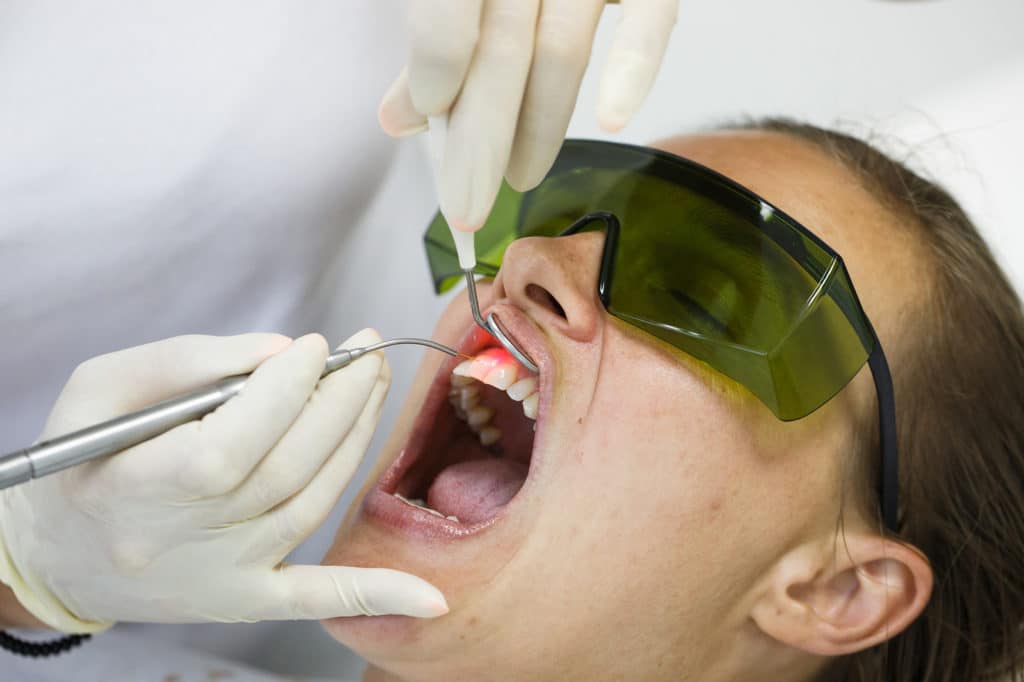Wavelength Optimised Periodontal Therapy

Wavelength Optimised Periodontal Therapy is used to treat Periodontal diseases. The word “periodontal” means “around the teeth”. A periodontal disease is caused by Gram-Positive & Gram Negative bacteria living around the neck of the teeth which releases endotoxins from the bacteria which lead to severe infections in the gums and the loss of supporting bones that hold your teeth together. When body tissue falls ill or compromised in immune response, the gingiva will swell, which causes the blood flow to increase and helps in the repair. But between the teeth, there is very little space for blood vessels to move in and out and hence the supporting bone dissolves to make way causing periodontal diseases.
 WPT creates optimal conditions for healing of infected periodontal pockets.
WPT creates optimal conditions for healing of infected periodontal pockets.
Periodontal Therapy
Treatments for Periodontal diseases range from nonsurgical to surgical other than medication i.e. using drugs to treat periodontal disease. Non-surgical treatment would include cleaning, scaling and root planning whereas surgical would include Flap surgery, pocket reduction surgery, bone or tissue grafting, guided tissue regeneration and bone surgery. Dentists now look at advanced technologies to treat periodontal diseases – Laser Periodontal treatment is gaining popularity in many places. One such is “Wavelength optimism periodontal therapy” also known as “WPT”. [vc_video link=”https://youtu.be/4byD8aarIds”]What is Wavelength optimised periodontal therapy?
Wavelength optimism periodontal therapy is a minimally invasive method to treat periodontal diseases using Nd: YAG and ER: YAG laser energy. These two wavelengths having unique clinical and therapeutic abilities are used to treat periodontal diseases in the best way. Instead of a sharp knife that would peel off the gum or teeth, thin laser quartz would be inserted between the tooth and the gum line to remove the diseased tissue.How does WPT work?
 WPT creates optimal conditions for healing of infected periodontal pockets.
WPT creates optimal conditions for healing of infected periodontal pockets.
- Nd: YAG laser helps to destroy harmful periodontal bacteria (Gram positive & Gram negative) by removing the infected epithelial lining of the pocket.
- The Er: YAG laser is then used to removes tartar buildup and biofilm from the root surface.
- After the above treatment, the pocket is sealed with a stable fibrin clot using the Nd: YAG again. This seals off the pocket and promotes healing and bone regeneration.
- Removal of endotoxins from the root surface and epithelial lining
Benefits of WPT or Wavelength Optimised Periodontal Therapy
WPT serves as a painless option to kill harmful oral bacteria, preserves teeth that may have been lost if standard periodontal disease treatments were used. Other benefits include:- Prevents cutting the gums, sutures, soreness and other discomfort caused by surgery
- Seals deep periodontal pockets
- Reduces or prevents loose teeth
- Regenerates bone and ligament tissue
- Greater success ratio when compared to traditional flap surgery
- less tissue shrinkage when compared to the conventional method
- One or two visits are sufficient when compared to conventional method.
- Minimally invasive treatment
